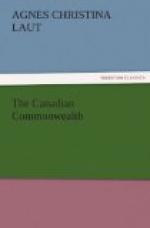The discovery of silver at Cobalt came by an almost similar chance. Grading an extension of a North Ontario railroad projected purely for the sake of prospective settlers, workmen came on surface deposits of “rose” silver—almost pure metal, some of it; and there resulted such a mining boom and series of quick fortunes as had made Klondike famous. And Cobalt and Sudbury are at only the southern edge of the unexplored hinterland of Ontario. Old records of the French regime, daily journals of the Hudson’s Bay Company fur-traders, repeatedly refer to well-known mines between Lake Superior and James Bay; but fur-traders discouraged mining; and this region is less known to-day than when coureur de bois and voyageur threaded river and lake and leafy wilderness. Ontario, like Quebec, is only on the outer edge of realizing her own wealth.
V
We sometimes speak as though Canada had had her boom and it was all over. She has had her boom, and the boom has exploded, and it is a good thing. When inflation collapses, a country gets down to reality; and the reality is that Canada has barely begun to develop the exhaustless mine of wealth which Heaven has given her. Ontario, complacent with a fringe of prosperity along lake front, is an instance; Quebec, with only a border on each bank of her great rivers peopled, is another instance; and the prairie provinces are still more striking illustrations of the sleeping potentialities of the Dominion. In our dark days we used to call those three prairie provinces between




